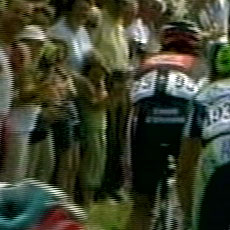Video rip. Part 2-1. What is interlace and what it is eaten with
Content
- DVD preparation
- Video processing
- What is interlace and what it is eaten with
- How to determine what we have: progressive, interlaced or telecined?
- Getting rid of ordinary interlacing (deinterlace)
- IVTC
- Squeeze and pack
In this article, we learn what interlace, deinterlace, telecine, pulldown, ivtc are and how it all together complicates life.
All video signals can be divided into two categories: interlaced and progressive.
')
Interlace, in our interlaced scanning, as a method, was invented by Lev Sergeyevich Termen in 1927. Its essence lies in the fact that the TV frame consists of several hundred lines. Lines are displayed on the screen not one after the other, but through one, thus dividing the frame into two half-frames. Thus, the image on the TV is updated at a rate of 50 (PAL) or 60 (NTSC) half-frames per second. A field that begins with an odd string is called odd or upper, respectively, another, even or lower. Thanks to this method, we get a good quality image on the TV screen without increasing bandwidth (as well as problems with rip).
Progressive is a video without interlacing. We will not discuss it because no necessary transformations are required on it.
Freedom from interlacing is called deinterlace. This should be done because on a computer screen, for example, a video with interlacing will be perceived as a video with noise, with such an unpleasant “comb” look.

There are two factors that can prevent us from getting rid of it.
Firstly, if the video is recorded by the camera immediately in the PAL or NTSC broadcast standards, then the two half-frames going one after the other together do not represent one frame. The gap between two half frames is 1/50 (PAL) or 1/60 (NTSC) seconds. This means that we simply cannot connect them.
Secondly, we will be hampered by the telecine procedure. It is used to convert from 24 FPS (standard number of frames per second for films shot on film) to PAL or NTSC. Telecine consists of two words, television and cinema. Generally speaking, telecine usually means duplication of some frames or so-called. pulldown.
There are 4 most common types of pulldown:
- PAL 2: 2. It is done very simply. Each frame of the original movie is divided into two fields. The result is 48 fields per second. Then the playback speeds up by 4% and we get the required 50 half-frames per second. This method is bad for movies in which sound is important, because after its application it is distorted (becomes higher). Picture Look from top to bottom, from left to right.
- PAL 2: 2: 2: 2: 2: 2: 2: 2: 2: 2: 2: 2: 3. Applies to videos where sound is important. Every 12th frame lasts not two half-frames, but three.
- NTSC 2: 3. The most cunning method. It is done in two steps. For a start, the original video slows down to 23.976 (24 * 1000/1001). After that, they do it like this . The picture is viewed from top to bottom, from left to right.
- NTSC 2: 2. Similar to PAL 2: 2 and applies if the source FPS = 30.
In other words, the image after telecine is likely to be restored in its original form, but the image captured by the camera is probably not there.
Results
Video is initially interlaced and subjected to telecine. It is also worth remembering that in addition to the described telecine methods there are various others, there are broken files and in general a lot of things are found. In such cases, it is difficult to give unambiguous advice, it is necessary to apply ingenuity. I hope that all those techniques and tools that will be discussed later will help you with this.
On the methods of struggle in the next issues.
Links
en.wikipedia.org/wiki/Telecine
en.wikipedia.org/wiki/Interlace
forum.1dv.ru/index.php?s=&showtopic=24955&view=findpost&p=194039
www.mplayerhq.hu/DOCS/HTML/ru/menc-feat-dvd-mpeg4.html
Source: https://habr.com/ru/post/51201/
All Articles